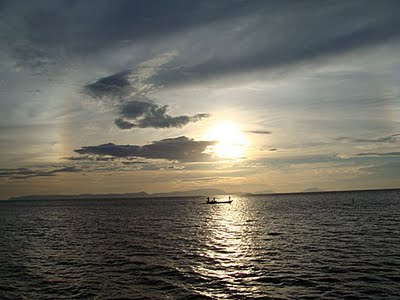 The sun is setting off the coast of Kep - a view I never tire of
The sun is setting off the coast of Kep - a view I never tire of
So where and what have I been doing? Left Phnom Penh on Friday afternoon in Dan's car and we made it to the town of Tani as it was getting dark, so we stopped for a quick look at the ruined laterite prasat that sits in front of the main pagoda there. It's 11th century but looks older, there was no carvings to speak of and a tree has made its home in the middle of the parasat. And the old wat which contained some wonderful wall paintings I'm told, has been demolished. We carried onto Kampot and I took a room at Dan's new comfortable guesthouse, The Magic Sponge, near the salt workers' roundabout. I had time for a meal at the Rusty Keyhole and then early to bed. Up at 7am I was out to the Nataya Roundhouse Resort, 17kms west of Kampot, just off the road to Sihanoukville, at Prek Ampil, next morning. This is a brand new resort, with some nicely finished bungalows, and best of all, a 1km long beach. A swimming pool is being constructed, another eight bungalows are also being built and it looks like a nice option for Kampot lovers. I stopped at a trio of pagodas on the way back, a couple of railway stations and then visited a few hotels to say hello.
After lunch, I directed my motodop towards Kep, stopping at a couple of genocide memorials en route, at Wat Chum Kriel and Wat Kompong Tralach. Once I hit Kep I made house-calls at Knai Bang Chatt, the Sailing Club, the new FCC-owned house called Eskepe, which is just being finished off, Veranda (who are building a pool), and the new pizza restaurant at the crab market, La Bakara, where I bumped into Jean-Michel Filippi, who invited me to a lecture he was giving that evening. We then headed off into the mountains at Phnom Voar to visit a new eco-friendly guesthouse called The Vine Retreat but didn't stay long as they were in the middle of their opening party. Before dinner at the Riel Bar, I went to Champey Inn for Jean-Michel's lecture on the pre-Angkorian era in Kampot region, where he mentioned the region's first museum he is hoping to build by the White Horse monument in the near future. What he doesn't know about Kampot and Kep you could write on a postage stamp. Another early night, at Kep Seaside GH, there's not much to do in Kep to be honest, and then it was back to town on the bus this morning. As I said, all work and no time for fun.
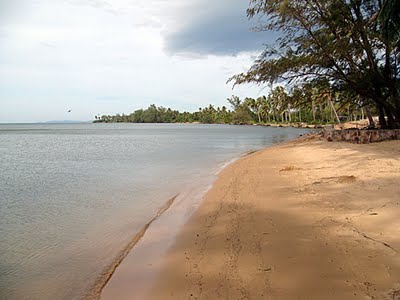 The beach at Nataya Roundhouse Coral Bay Resort, 17kms from Kampot
The beach at Nataya Roundhouse Coral Bay Resort, 17kms from Kampot
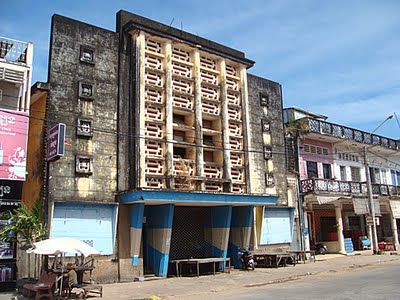 The old cinema in Kampot, now closed but a hive of activity during the golden years of Cambodian film in the 1960s
The old cinema in Kampot, now closed but a hive of activity during the golden years of Cambodian film in the 1960s
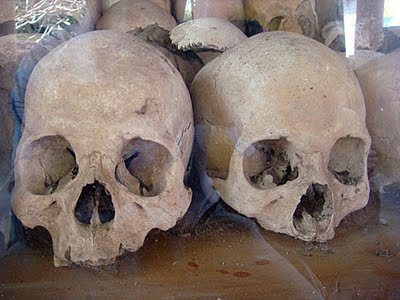 Two Khmer Rouge victims at the small memorial at Wat Chum Kriel, 5kms outside Kampot
Two Khmer Rouge victims at the small memorial at Wat Chum Kriel, 5kms outside Kampot
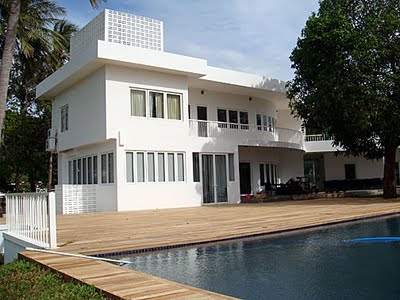 Kep: Not yet open but already looking resplendent, Eskepe, related to the FCC chain
Kep: Not yet open but already looking resplendent, Eskepe, related to the FCC chain
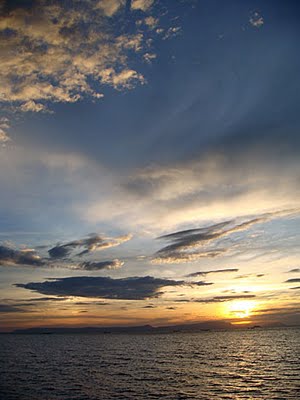 Another sunset picture taken from my guesthouse in Kep
Another sunset picture taken from my guesthouse in KepLabels: Jean-Michel Filippi, Kampot, Kep
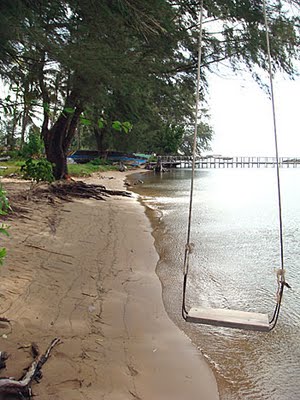 The 1km beach at Nataya is a big attraction. I think it used to be the Queen's favourite beach in bygone times.
The 1km beach at Nataya is a big attraction. I think it used to be the Queen's favourite beach in bygone times. The 1km beach at Nataya is a big attraction. I think it used to be the Queen's favourite beach in bygone times.
The 1km beach at Nataya is a big attraction. I think it used to be the Queen's favourite beach in bygone times. The old cinema in Kampot, now closed but a hive of activity during the golden years of Cambodian film in the 1960s
The old cinema in Kampot, now closed but a hive of activity during the golden years of Cambodian film in the 1960s